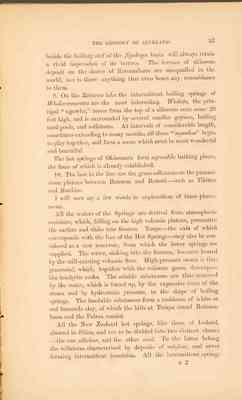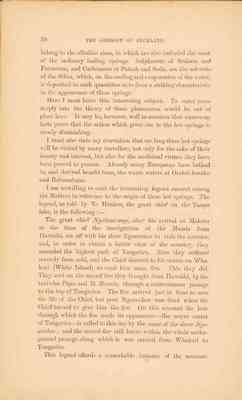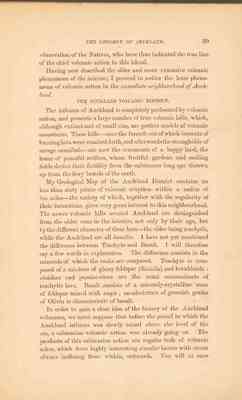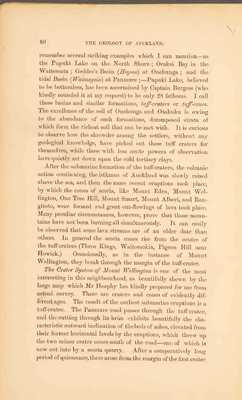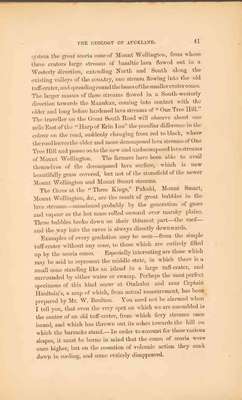Pages
THE GEOLOGY OF AUCKLAND. 37
beside the boiling surf of the Ngahapu basin will always retain a vivid impression of its terrors. The terrace of siliceous deposit on the shores of Rotomahana are unequalled in the world, nor is there anything that even bears any resemblance to them.
9. On the Roturua lake the intermittent boiling springs of Whakarewarewa are the most interesting. Waikite, the principal "ngawha," issues from the top of a siliceous cone some 20 feet high, and is surrounded by several smaller geysers, boiling mud-pools, and solfataras. At intervals of considerable length, sometimes extending to many months, all these "ngawhas" begin to play together, and form a scene which must be most wonderful and beautiful.
The hot springs of Ohinemutu form agreeable bathing places, the fame of which is already established.
10. The last in the line are the great solfataras on the pumicestone plateau between Rotorua and Rotoiti - such as Tikitere and Ruahine.
I will now say a few words in explanation of these phenomena.
All the waters of the Springs are derived from atmospheric moisture, which, falling on the high volcanic plateau, permeates the surface and sinks into fissures. Taupo - the axis of which corresponds with the line of the Hot Springs - may also be considered as a vast reservoir, from which the lower springs are supplied. The water, sinking into the fissures, becomes heated by the still-existing volcanic fires. High-pressure steam is thus generated, which, together with the volcanic gases, decompose the tracytic rocks. The soluble substances are thus removed by the water, which is forced up, by the expansive force of the steam and by hydrostatic pressure, in the shape of boiling springs. The insoluble substances form a residuum of white or red fumarole clay, of which the hills at Terapa round Rotomahana and the Pairoa consist.
All the New Zealand hot springs, like those of Iceland, abound in Silica, and are to be divided into two distinct classes - the one alkaline, and the other acid. To the latter belong the solfataras characterised by deposits of sulphur, and never forming intermittent fountains. All the intermittent springs D2
38 THE GEOLOGY OF AUCKLAND.
belong to the alkaline class, in which are also included the most of the ordinary boiling springs. Sulphurets of Sodium and Potassium, and Carbonates of Potash and Soda, are the solvents of the Silica, which, on the cooling and evaporation of the water, is deposited in such quantities as to form a striking characteristic in the appearance of these springs.
Here I must leave this interesting subject. To enter more deeply into the theory of these phenomena would be out of place here. It may be, however, well to mention that numerous facts prove that the action which gives rise to the hot springs is slowly diminishing.
I must also state my conviction that ere long these hot springs will be visited by many travellers, not only for the sake of their beauty and interest, but also for the medicinal virtues they have been proved to possess. Already many Europeans have bathed in, and derived benefit from, the warm waters at Orakei-korako and Rotomahana.
I am unwilling to omit the interesting legend current among the Natives in reference to the origin of these hot springs. The legend, as told by Te Heuhue, the great chief on the Taupo lake, is the following:-
The great chief Ngatiroirangi, after his arrival at Maketu at the time of the immigration of the Maoris from Hawaiki, set off with his slave Ngauruhoe to visit the interior, and, in order to obtain a better view of the country, they ascended the highest peak of Tongariro. Here they suffered severely from cold, and the Chief shouted to his sisters on Whakari (White Island) to send him some fire. This they did. They sent on the sacred fire they brought from Hawaiki by the taniwha Pupu and Te Haeata, through a subterranean passage to the top of Tongariro. The fire arrived just in time to save the life of the Chief, but poor Ngauruhoe was dead when the Chief turned to give him the fire. On this account the hole through which the fire made its appearance - the active crater of Tongariro - is called to this day by the name of the slave Ngauruhoe; and the sacred fire still burns within the whole underground passage along which it was carried from Whakari to Tongariro.
This legend affords a remarkable instance of the accurate
THE GEOLOGY OF AUCKLAND. 39
observation of the Natives, who have thus indicated the true line of the chief volcanic action in the island.
Having now described the older and more extensive volcanic phenomena of the interior, I proceed to notice the later phenomena of volcanic action in the immediate neighbourhood of Auckland.
The Auckland Volcanic District.
The isthmus of Auckland is completely perforated by volcanic action, and presents a large number of true volcanic hills, which, although extinct and of small size, are perfect models of volcanic mountains. These hills - once the funnels out of which torrents of burning lava were vomited forth, and afterwards the strongholds of savage cannibals - are now the ornaments of a happy land, the home of peaceful settlers, whose fruitful gardens and and smiling fields derive their fertility from the substances long ago thrown up from the fiery bowels of the earth.
My Geological Map of the Auckland District contains no less than sixty points of volcanic eruption within a radius of ten miles - the variety of which, together with the regularity of their formations, gives very great interest to this neighbourood. The newer volcanic hills around Auckland are distinguished from the older ones in the interior, not only by their age, but by the different character of their lava - the older being trachytic, while the Auckland are all basaltic. I have not yet mentioned the difference between Trachyte and Basalt. I will therefore say a few words in explanation. The difference consists in the minerals of which the rocks are composed. Trachyte is composed of a mixture of glassy feldspar (sanidin) and hornblende: obsidian and pumice-stone are the usual concomitants of trachytic lava. Basalt consists of a minutely-crystalline mass of feldspar mixed with augit; an admixture of greenish grains of Olivin is characteristic of basalt.
In order to gain a clear idea of the history of the Auckland volcanoes, we must suppose that before the period in which the Auckland isthmus was slowly raised above the level of the sea, a submarine volcanic action was already going on. The products of this submarine action are regular beds of volcanic ashes, which form highly interesting circular basins with strata always inclining from within, outwards. You will at once
40 THE GEOLOGY OF AUCKLAND.
remember several striking examples which I can mention - as the Pupuki Lake on the North Shore; Orakei Bay in the Waitemata; Geddes's Basin (Hopua) at Onehunga; and the tidal Basin (Waimagoia) at Panmure; - Pupuki Lake, believed to be bottomless, has been ascertained by Captain Burgess (who kindly sounded it at my request) to be only 28 fathoms. I call those basins and similar formations, tuff-craters or tuff-cones. The excellence of the soil of Onehunga at Otahuhu is owing to the abundance of such formations, decomposed strata of which form the richest soil that can be met with. It is curious to observe how the shrewder among the settlers, without any geological knowledge, have picked out these tuff craters for themselves, while those with less acute powers of observation have quietly sat down upon the cold tertiary clays.
After the submarine formation of the tuff-craters, the volcanic action continuing, the isthmus of Auckland was slowly raised above the sea, and then the more recent eruptions took place, by which the cones of scoria, like Mount Eden, Mount Wellington, One tree Hill, Mount Smart, Mount Albert, and Rangitoto, were formed and great out-flowings of lava took place. Many peculiar circumstances, however, prove that those mountains have not been burning all simultaneously. It can easily be observed that some lava streams are of an older date than others. In general the scoria cones rise from the centre of the tuff-craters (Three Kings, Waitomokia, Pigeon Hill near Howick.) Occasionally, as in the instance of Mount Wellington, they break through the margin of the tuff-crater.
The Crater System of Mount Wellington is one of the most interesting in this neighbourhood, as beautfully shown by the large map which Mr Heaphy has kindly prepared for me from actual survey. There are craters and cones of evidently different ages. The result of the earliest submarine eruptions is a tuff-crater. The Panmure road passes through the tuff-crater, and the cutting through its brim exhibits beautifully the characteristic outward inclination of the beds of ashes, elevated fom their fomer horizontal levels by the eruptions, which threw up the two minor crater cones south of the road - one of which is now cut into by a scoria quarry. After a comparatively long period of quiescence, there arose from the margin of the first crater
THE GEOLOGY OF AUCKLAND. 41
system the great scoria cone of Mount Wellington, from whose three craters large streams of basaltic lava flowed out in a Westerly direction, extending North and South along the existing valleys of the country, one stream flowing into the old tuff-crater, and spreading round the bases of the smaller crater cones. The larger masses of these streams flowed in a South-westerly direction towards the Manukau, coming into contact with the older and long before hardened lava streams of "One Tree Hill." The traveller on the Great South Road will observe about one mile East of the "Harp of Erin Inn" the peculiar difference in the colour on the road, suddenly changing from red to black, where the road leaves the older and more decomposed lava streams of One Tree Hill and passes on to the new and undecomposed lava streams of Mount Wellington. The farmers have been able to avail themselves of the decomposed lava surface, which is now beautifully grass covered, but not of the stonefield of the newer Mount Wellington and Mount Smart streams.
The Caves at the "Three Kings," Pukaki, Mount Smart, Mount Wellington, &c., are the result of great bubbles in the lava streams - occasioned probably by the generation of gases and vapour as the hot mass rolled onward over marshy plains. These bubbles broke down on their thinnest part - the roof - and the way into the caves is always directly downwards.
Examples of every gradation may be seen - from the simple tuff-crater without any cone, to those which are entirely filled up by the scoria cones. Especially interesting are those which may be said to represent the middle state, in which there is a small cone standing like an island in a large tuff-crater, and surrounded by either water or swamp. Perhaps the most perfect specimens of this kind occur at Otahuhu and near Captain Haultain's, a map of which, from actual measurements, has been prepared by Mr W. Boulton. You need not be alarmed when I tell you, that even the very spot on which we are assembled is the centre of an old tuff-crater, from which fiery streams once issued, and which has thrown out its ashes towards the hill on which the barracks stand. - In order to account for these various shapes, it must be borne in mind that the cones of scoria were once higher, but on the cessation of volcanic action they sunk down in cooling, and some entirely disappeared.
